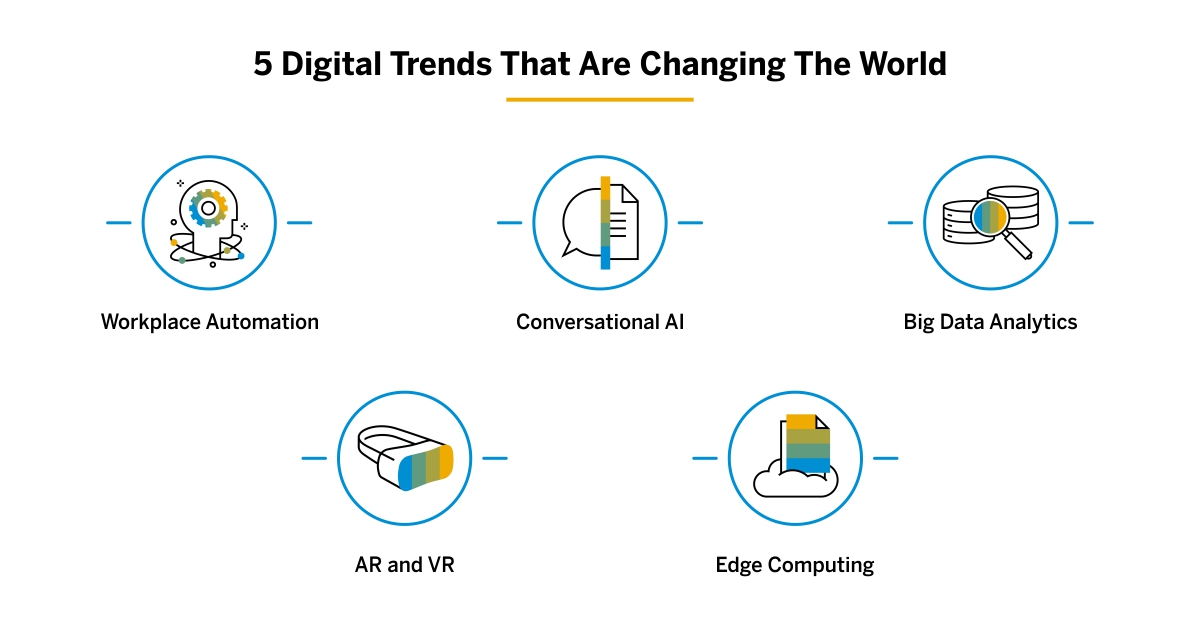According to entrepreneur and futurist Peter Diamandis, technology will alter health and materials sciences, energy, transportation, and a wide range of other areas in the next decade. Thus, more progress will be made than in the previous 100 years combined. The ramifications of this for businesses are numerous and exciting, yet also somewhat challenging.
In the connected world we see today, companies rely heavily on technology and reimagining their business models. The IT industry is probably at its highest point since its inception as the world tries to align itself with a digital-first future. According to the IDC Worldwide Digital Transformation Spending Guide, 65% of global GDP is likely to be digitalized by 2022 and will drive over $6.8 trillion of direct DX investments from 2020 to 2023. The guide also predicts that by 2022, 70% of all organizations will see accelerated use of digital technologies, transforming existing business processes to drive customer engagement, employee productivity, and business resiliency.
As digital reality becomes our only reality, businesses are turning to digital IT tools to keep up with the demands of continually changing customer expectations. They are now eager to embrace the latest digital IT trends and rethink their IT system management. Interestingly, the most significant trends may not exactly be cutting-edge, but they are causing maximum impact in the business landscape. Here are five of them:

Workplace Automation:
Automation isn’t a new trend; but it will be seen in more fascinating and transformational ways in the following years. While future automation technology holds vast scope, even today’s technological advancements are adequate to automate tedious manual processes and streamline workflows. Automation can help enhance productivity, utilize resources better and increase customer satisfaction levels.
According to IDC, 50 percent of knowledge workers will engage with their own AI-enhanced robot assistant on a regular basis, which will support them in identifying and prioritizing tasks, collecting data, and automating repetitive chores. Meanwhile, Gartner predicts hyperautomation will play a massive role in the future. It is referred to as a tech trend where companies combine AI, IoT, machine learning and robotic process automation to enhance the ways people complete their tasks.
Conversational AI:
When the pandemic struck, many businesses turned to conversational AI to sustain and improve customer and employee communications. It took away the burden of routine transactions and processes from employees and helped them focus on strategic initiatives.
Today, conversational AI has become a mandate for success for any organization, especially those dealing with a huge volume of customer service queries. There has been an addition of innovative technologies to its cognitive capabilities, leading to increased market demand for AI skillsets.
Conversational AI has evolved with the deployment of chatbots and virtual agents, coupled with adjacent technologies like NLP (Natural Language Processing) for contextual understanding. It can better understand and mimic human language and deliver highly personalized conversations.
Big Data Analytics:
Big data analytics is playing an integral role in the digitization and automation of business operations. It has emerged as a game-changer for all types of organizations, from SMEs to global behemoths. According to a report by Gartner, executives accelerated their investment in data analytics even during the pandemic, when overall IT spending was on a decline.
As the amount of generated data continues to grow exponentially, big data analytics is playing an integral role in enabling data-driven decision-making. Within the umbrella term of big data analytics, decision intelligence is a theme that is rapidly gaining popularity. It includes a variety of decision-making methodologies for designing, modeling, aligning, deploying, and tracking decision models and processes. It also consists of a framework that combines rules-based approaches and modern techniques like AI and machine learning.
Overall, big data analytics allows organizations to use meaningful patterns to make data-driven decisions, predict future outcomes and detect anomalies in operations. For this, an organization needs to have proper database management as a first step. Organizations adopting enterprise data management can achieve the goals of their data analytics journey faster.
AR and VR:
For most of us, our initial experience of Artificial Reality (AR) and Virtual Reality (VR) was through social media or gaming. Of late, there has been a deepening realization of the immense potential of AR and VR in business. These technologies make it possible to create a digital environment for customers that matches their demands, responds to real-time stimuli, and tracks their activities.
For example, automobile manufacturers are utilizing augmented and VR business developments to make car-buying more convenient for all customers. Customers can locate the precise automobile they want, take a virtual test drive, and even apply for finance directly from the VR car showroom.
With the support of AR/VR communication systems, reporting programs and mobile storage apps, many sectors, such as retail businesses and service providers, have been able to stay afloat during and after the pandemic. AR and VR also hold exciting possibilities for a big chunk of the workforce that is now remote or hybrid. There are remote assistance programs and immersive alternatives to videoconferencing available now. New technologies allow candidates to ‘virtually shadow’ existing employees or visit a company’s office without leaving their homes.
Edge Computing:
Edge computing is increasingly becoming a valuable component of a holistic industrial automation strategy. Targeted at improving performance and lowering latency in widely dispersed networks, edge computing has unveiled new business opportunities and enhanced operational efficiency within the IT infrastructure.
With the rise of the Internet-of-Things (IoT), organizations are expected to reshape their IT infrastructure to gain maximum benefits. Edge computing will be required by IoT devices such as manufacturing floor robotics and intelligent traffic controllers, which will require localized processing and real-time connectivity. As remote working becomes the norm, businesses can also improve application performance and overall user experiences for remote workers with edge resources.
Partner with Experts
Gearing up for Industry 4.0 is a massive undertaking and given the rapid pace of change, digital technologies will become wholly integrated into the business ecosystem very soon. SAP focuses on simplifying enterprise IT with the use of futuristic technologies and helps organizations achieve digital transformation quickly and cost-effectively.




